COVID-19 Outlook: The Memorial Day Effect Comes into View

We are in the midst of the most important weeks of our COVID-Lab forecasts, at least as they pertain to the outlook for summer. More than two weeks out from Memorial Day, we’ve had sufficient time to see whether increased traffic on that holiday weekend resulted in a resurgence of COVID-19, which would give us an indication of what the rest of summer could entail. The mixed picture we’ve found appears to reinforce many of the key principles we have been emphasizing about how to control transmission of this disease in communities across the United States.
The most important takeaway this week is that underlying case counts are a huge risk when social contact begins increasing. Even if reproduction numbers (or the number of additional people infected by each case) are only slightly elevated above 1, the impact on local disease activity is more significant if a community has several hundred new cases a day, compared to tens, when travel and mixing increases. There are just so many more opportunities for transmission.
As a result, we are not surprised that those areas that entered Memorial Day weekend with significant disease burden or elevated risk in our previous projections saw the situation on the ground worsen—holiday traffic seemed to elevate cases in areas that were already of concern. We are predicting increasing risk for resurgence on Florida’s west coast (Tampa and Clearwater area), which saw a huge surge in traffic during the holiday. North Carolina and South Carolina are now seeing a wave of growing risk forecasted in most of their larger cities. The Houston and Dallas areas have continued to worsen, and we are hearing concerns from colleagues about limited ICU capacity in the Houston area if disease burden does not improve in the next couple of weeks. Galveston, a beach destination in Texas, and Brownsville, near the popular Padre Island, are feeling the effects of the sheer volume of new cases, which continue to compound their future risk. El Paso continues its slide.
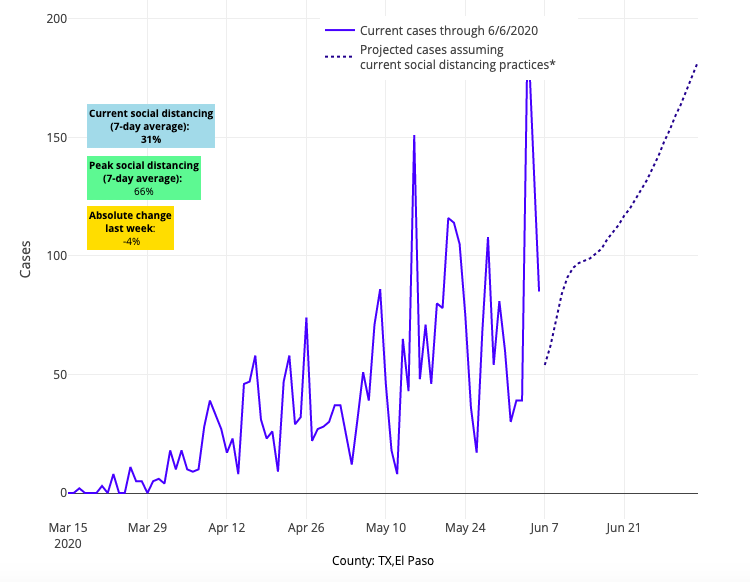
Above are the projections for El Paso County in Texas.
But we must also acknowledge that we are not projecting many areas that saw increased holiday traffic to have a major resurgence. Beach destinations along the Northeast and mid-Atlantic coast are forecasted to maintain their case counts. Even the Lake Michigan area, which had looked troubling last week, has a more stable outlook as of this week. Notably, our projections have improved for Savannah, Ga., and Virginia Beach, as well as their feeder cities. Atlanta still has its delicate equilibrium, and projections for Boston, Chicago, Philadelphia and New York City continue to improve. We’re still projecting that many of our most rural areas will have a (relatively) normal summer, and we continue to be impressed by how Colorado, Ohio and Pennsylvania (no bias here) have been able to contain any additional spread of the virus as they’ve reopened.
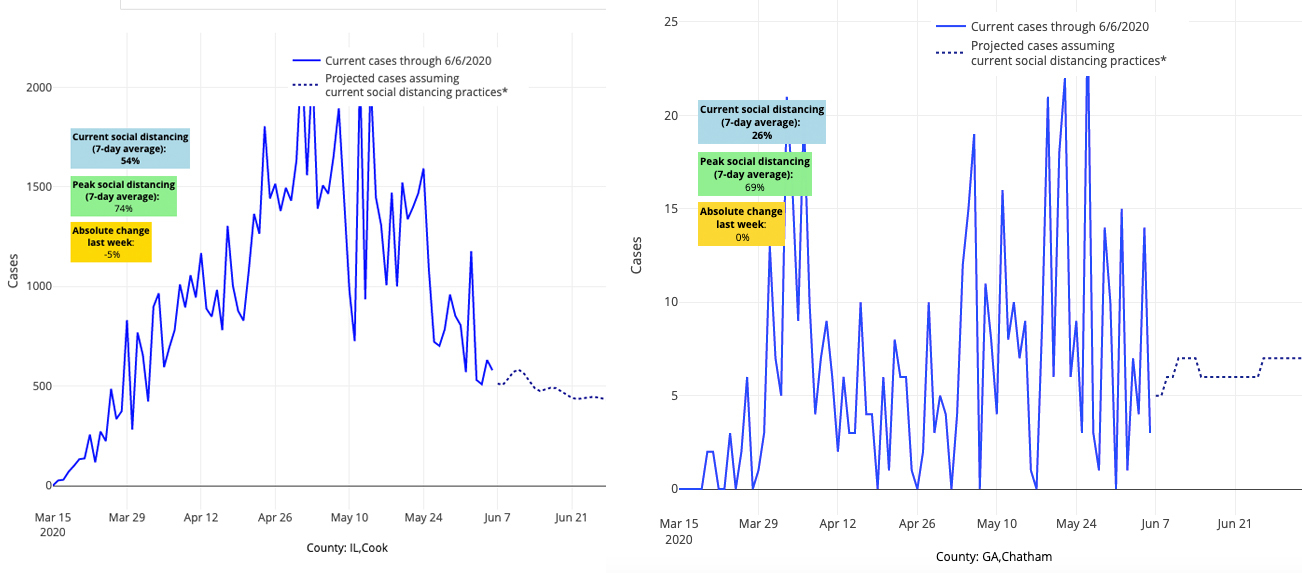
Above are the projections for Cook County in Illinois (left) and Chatham County in Georgia (right).
However, what’s been especially interesting to us this week is the sense that, over time, the main epicenters of the pandemic have swept across the country from east to west, even as the south’s delicate balance between reopening and resurgence has captivated our attention. The first epicenters were in New York City and the Northeast; next, the Midwest and Upper Midwest. Today, our focus is squarely in the Southwest of the country where counts continue to climb quickly and we’re projecting high risk for a second wave of widespread community transmission.
From Arizona to Los Angeles, up from the Imperial and Inland Empire areas of San Diego and Los Angeles, and now spreading up to the central valley of California, and through to Provo and Salt Lake City, Utah, it appears that widespread community transmission is taking hold in the Southwest. The increasing infections in this region are disproportionately responsible for rising daily case counts across the country. It is hard to tell what is driving this new epicenter—to some degree reopening and concerns about vigilance are contributing. But the magnitude of this resurgence suggests other dynamics as well. We wonder about the early onset of fire season in Arizona; are displacement, sheltering and the increase in smoke pollution creating new dynamics? Are the number of retirees in the area helping fuel new outbreaks? These local dynamics require their own investigation.
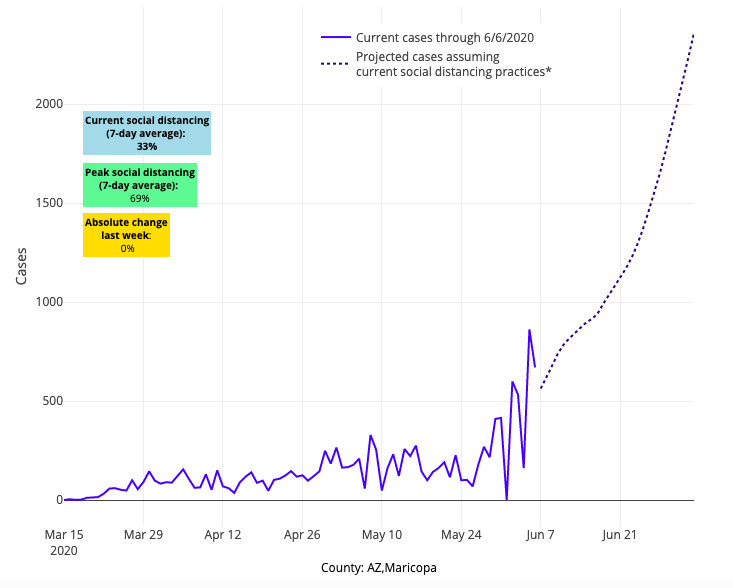
Above are the projections for Maricopa County in Arizona.
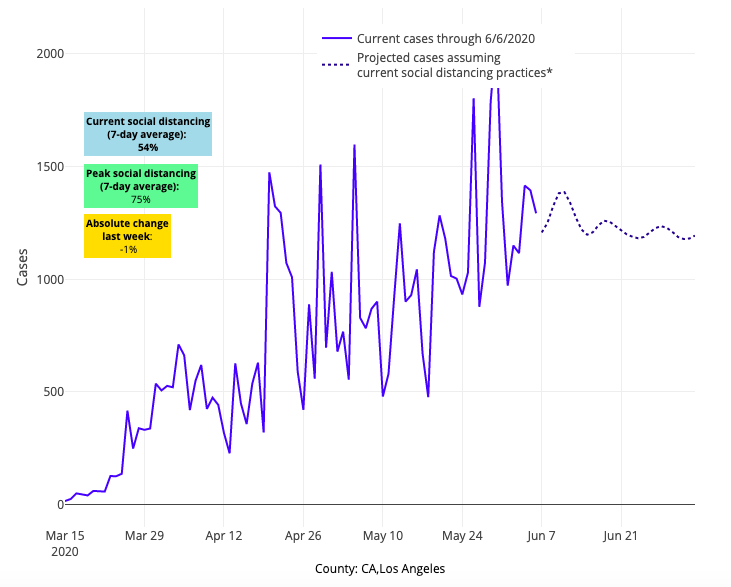
Above are the projections for Los Angeles County in California.
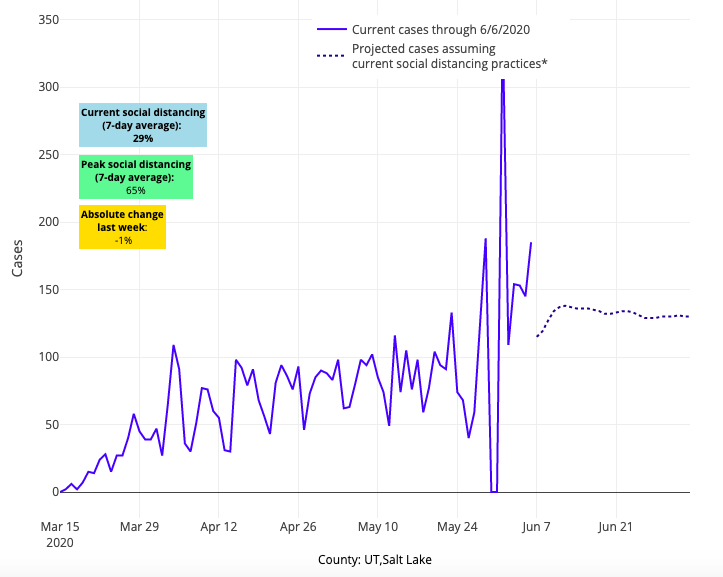
Above are the projections for Salt Lake County in Utah.
To some degree, we have tried to be careful to distinguish local outbreaks versus widespread community transmission. For example, Riverside County, Calif., clearly has had outbreaks related to their prison population. When we see rising case projections in our models, we first review local news to see if they are reporting outbreaks that have led to swift increases in incidence as new cases are identified through contact tracing. Locally contained outbreaks often abate within a week or two. But local outbreaks and community transmission are often not mutually exclusive; when you see continued spread throughout a region, it is hard to invoke a contained local outbreak as the source. And the problem with local outbreaks in nursing homes, processing centers, and prisons is that the staff often travel far and wide and can become a source of transmission for neighboring communities. That’s why a mitigation strategy that emphasizes the protection of vulnerable locations is critical, not only to avoid becoming the next outbreak location, but also to prevent an ongoing crisis in your community from becoming even worse.
Understanding the individual and community routines that differentiate Atlanta from Houston will be critical to informing the most successful reopening strategies. When we do so, we suspect we’ll see that wearing masks in crowded indoor locations, focusing on hygiene and disinfection, and protecting your locations at high-risk for outbreaks are a simple recipe to contain transmission.
By next week, we’ll have a fuller picture of the complete impacts of both Memorial Day and the demonstrations following George Floyd’s murder. To the degree that outdoor transmission is low and further mitigated by the arrival of summer weather, we remain cautiously optimistic that we might not see significant spikes in disease activity in many of our cities, even with mass outdoor gatherings. For those hotspots across Texas, the Southwest, and increasingly within the lower mid-Atlantic states and Florida, only time will tell if, in the balance, their swiftness to reopen helped their communities recover more quickly, or if the extra suffering many have endured eventually catches up to them and leads policymakers to pull back on their strategy.
This blog post was updated at 4:33 p.m. ET on June 10, 2020.
Gregory Tasian, MD, MSc, MSCE, is an associate professor of urology and epidemiology and a senior scholar in the Center for Clinical Epidemiology and Biostatistics at the University of Pennsylvania Perelman School of Medicine. He is also an attending pediatric urologist in the Division of Urology at Children's Hospital of Philadelphia.

